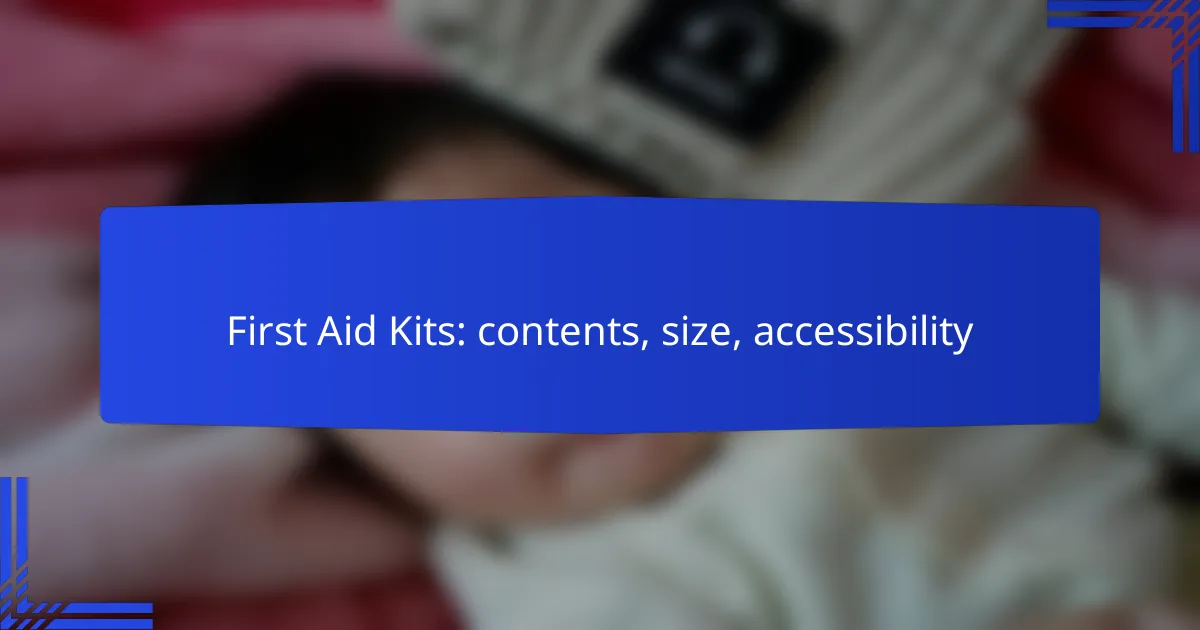A first aid kit is essential for addressing common injuries and emergencies, containing supplies like adhesive bandages, antiseptic wipes, and gauze pads. The appropriate size of the kit varies based on your activities and the number of people it needs to support, with personal kits suitable for individuals and larger kits recommended for families or workplaces. Accessibility is crucial, as the kit should be strategically located for quick response in case of emergencies.
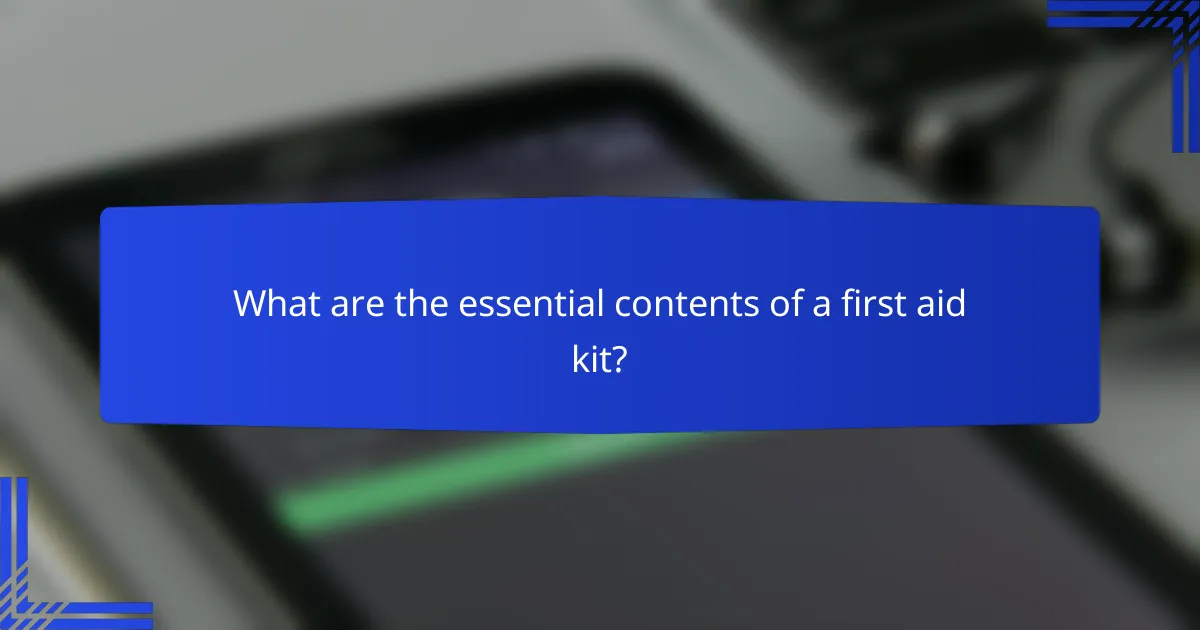
What are the essential contents of a first aid kit?
A first aid kit should contain a variety of supplies to address common injuries and emergencies. Essential items include adhesive bandages, antiseptic wipes, gauze pads, medical tape, and scissors, among others, ensuring you are prepared for minor injuries and some more serious situations.
Adhesive bandages
Adhesive bandages are crucial for covering small cuts and abrasions. They come in various sizes and shapes, allowing for flexibility in treating different types of wounds. It’s advisable to have a mix of standard and larger bandages to accommodate various injuries.
When selecting adhesive bandages, consider options with breathable materials and waterproof features for better protection. Regularly check the expiration dates and replace any that have dried out or lost their adhesive properties.
Antiseptic wipes
Antiseptic wipes are essential for cleaning wounds to prevent infection. These wipes typically contain alcohol or other antiseptic agents that effectively kill bacteria. Having a sufficient supply in your first aid kit is important for maintaining hygiene during treatment.
Choose wipes that are individually packaged for convenience and portability. Ensure they are suitable for sensitive skin if you or your family members have allergies or skin sensitivities.
Gauze pads
Gauze pads are used to absorb blood and protect larger wounds. They come in various sizes, and it’s important to have a selection to address different types of injuries. Gauze pads can be used in conjunction with adhesive bandages for optimal coverage.
When using gauze pads, apply them directly to the wound and secure them with medical tape to keep them in place. Regularly check your supply and replace any pads that have been used or are nearing expiration.
Medical tape
Medical tape is vital for securing gauze pads and dressings in place. It comes in various widths and adhesive strengths, allowing you to choose the best option for your needs. Look for tape that is hypoallergenic to minimize skin irritation.
Ensure the tape is easy to tear and adheres well to both skin and gauze. Keep a roll in your first aid kit to ensure you can effectively manage larger wounds or injuries that require additional support.
Scissors
Scissors are an important tool in a first aid kit, useful for cutting tape, gauze, or clothing in emergencies. A pair of blunt-tipped scissors is recommended to reduce the risk of accidental injury while providing effective cutting capability.
Store scissors in a protective case within the kit to prevent damage and ensure they remain sharp. Regularly check their condition and replace them if they become dull or rusted.

What size first aid kit do I need for New Zealand?
The size of the first aid kit you need in New Zealand depends on your specific activities and the number of people you intend to support. Generally, personal kits are suitable for individual use, while larger kits are recommended for families or workplaces to ensure adequate coverage for various situations.
Small kits for personal use
Small first aid kits are ideal for individuals and can easily fit in a backpack or glove compartment. These kits typically include essential items such as adhesive bandages, antiseptic wipes, and pain relievers. When selecting a small kit, ensure it contains the basics to handle minor injuries or ailments.
For personal use, consider a kit that meets your specific needs, such as including allergy medications if you have known sensitivities. Regularly check and replenish supplies to keep the kit ready for emergencies.
Medium kits for family outings
Medium first aid kits are suitable for family outings, accommodating the needs of several people. These kits often include additional supplies like gauze pads, elastic bandages, and a digital thermometer. When planning a family trip, choose a kit that can address common injuries and illnesses that may occur during outdoor activities.
It’s wise to customize your medium kit based on your family’s specific activities, such as including insect bite relief for camping trips or extra sunscreen for beach outings. Regularly review the contents to ensure everything is up to date and in good condition.
Large kits for workplaces
Large first aid kits are essential for workplaces, especially where there are multiple employees or potential hazards. These kits should comply with New Zealand’s health and safety regulations, containing items like splints, burn dressings, and a first aid manual. Ensure that the kit is easily accessible to all employees and that staff are trained in its use.
Consider the specific risks associated with your workplace when selecting a large kit. For example, construction sites may require additional items like eye wash solutions. Regularly inspect the kit to replace expired items and ensure it meets the evolving needs of your workplace environment.
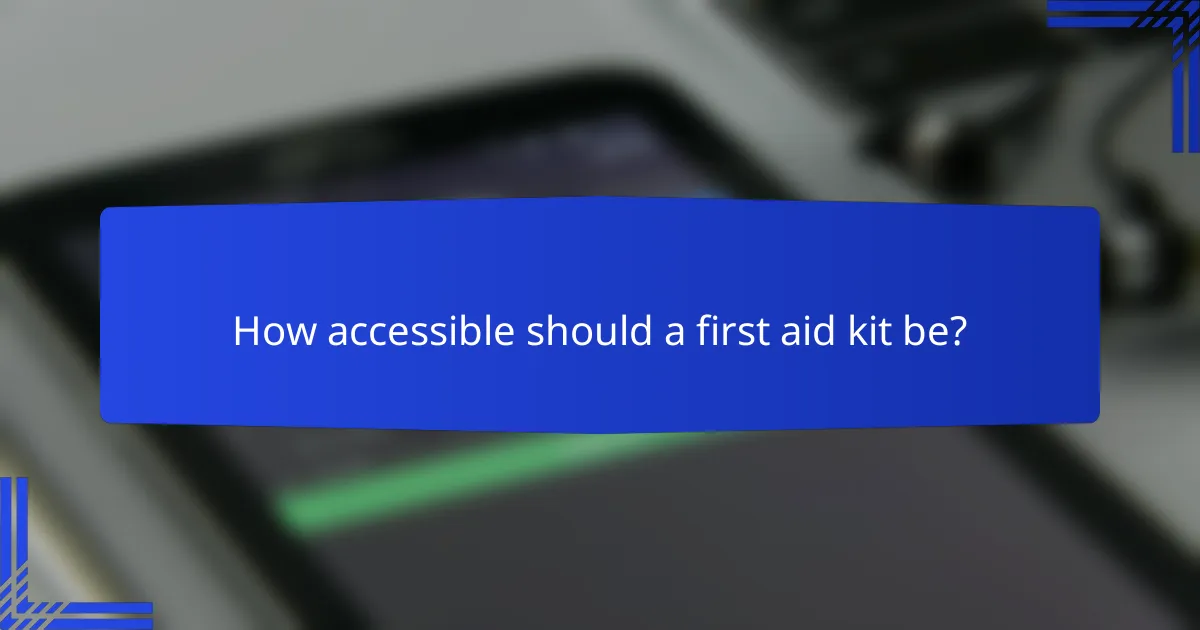
How accessible should a first aid kit be?
A first aid kit should be easily accessible in case of emergencies, allowing for quick response to injuries or medical issues. Its location should be strategic, ensuring that it can be reached without delay by anyone in need.
Location in homes
In homes, a first aid kit should be placed in a central location, such as the kitchen or a hallway, where it can be quickly accessed. Consider keeping it in a cabinet that is easy to open and clearly labeled for visibility.
It’s advisable to have multiple kits in larger homes, especially if there are different levels or areas where injuries might occur, such as a garage or workshop. Regularly check the contents to ensure supplies are stocked and not expired.
Accessibility in vehicles
For vehicles, a first aid kit should be stored in an easily reachable spot, such as the glove compartment or trunk. Ensure it is secured to prevent movement during travel, which could lead to spills or damage.
Consider the climate when choosing a kit for your vehicle, as extreme temperatures can affect the integrity of supplies. Regularly inspect the kit to replace any used items and check for expiration dates.
Availability in public spaces
In public spaces, first aid kits should be readily available in areas like schools, offices, and recreational facilities. These kits are often located in common areas, such as break rooms or near entrances, and should be clearly marked for easy identification.
Organizations should ensure that their first aid kits comply with local regulations and are stocked according to the size of the facility and the number of people it serves. Regular training for staff on how to use the kit can enhance safety and preparedness in emergencies.
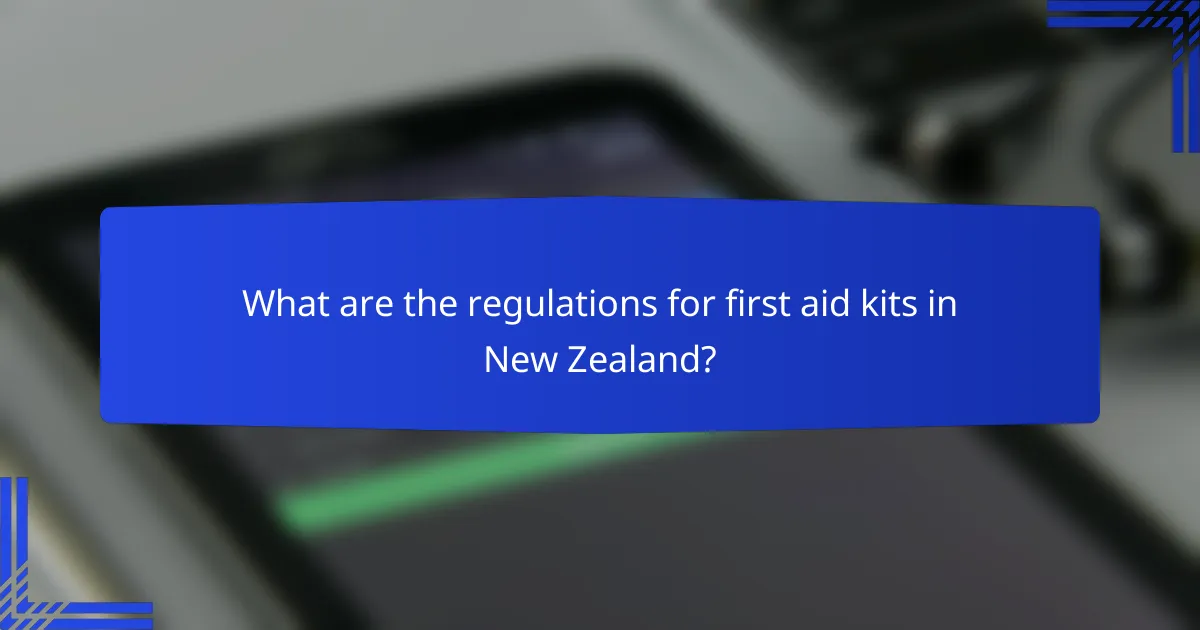
What are the regulations for first aid kits in New Zealand?
In New Zealand, first aid kits must comply with specific regulations that ensure they are adequately stocked and accessible. These regulations are primarily guided by the Health and Safety at Work Act, which mandates that workplaces maintain appropriate first aid facilities based on their size and nature of work.
Workplace health and safety requirements
Under New Zealand’s health and safety regulations, employers are required to provide first aid kits that are suitable for their workplace environment. The kit should include items such as adhesive bandages, antiseptic wipes, and dressings, tailored to the potential risks associated with the specific workplace.
Employers must also ensure that first aid kits are easily accessible to all employees and that designated first aiders are trained to use the contents effectively. Regular checks should be conducted to restock and replace expired items, ensuring that the kit remains compliant and functional.
Public event guidelines
For public events in New Zealand, organizers must adhere to guidelines that specify the minimum requirements for first aid kits. These kits should be stocked with essential supplies, including a variety of bandages, sterile gauze, and emergency contact information for local medical services.
The size and contents of the first aid kit should correspond to the expected number of attendees and the nature of the event. It is advisable to have trained first aid personnel on-site and to conduct a risk assessment prior to the event to determine the specific needs for first aid provisions.
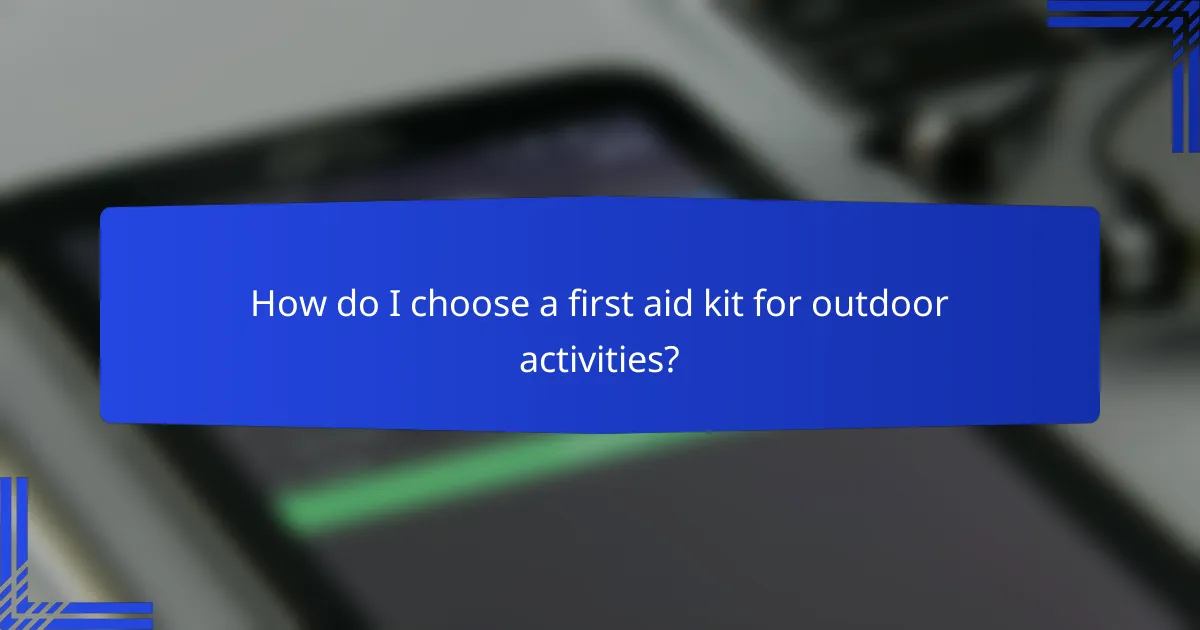
How do I choose a first aid kit for outdoor activities?
Choosing a first aid kit for outdoor activities involves assessing your specific needs based on the type of activity, group size, and potential risks. A well-equipped kit should contain essential supplies tailored to the environment and duration of your outing.
Considerations for hiking
When selecting a first aid kit for hiking, consider the length of your hike and the number of participants. For short day hikes, a compact kit with basic supplies may suffice, while longer treks might require a more comprehensive kit with additional items like splints or emergency blankets.
Ensure your kit includes items for common hiking injuries, such as adhesive bandages, antiseptic wipes, and pain relievers. It’s also wise to include a whistle and a map for navigation in case of emergencies.
Contents for camping
A camping first aid kit should be more extensive than a hiking kit due to the longer duration and potential for more serious injuries. Key contents should include a variety of bandages, gauze pads, and a tourniquet for severe bleeding, as well as medications for allergies and insect bites.
Consider including a first aid manual for reference, especially if camping in remote areas. A small supply of tools, such as scissors and tweezers, can also be beneficial for treating injuries effectively.

What are the differences between commercial and DIY first aid kits?
Commercial first aid kits are pre-packaged and designed to meet specific safety standards, while DIY first aid kits are customized by individuals to suit personal needs. Each option has its advantages and considerations, particularly regarding cost, contents, and accessibility.
Cost comparison
Commercial first aid kits typically range from $20 to $100, depending on the size and included items. In contrast, DIY kits can be more economical, as individuals can select only the supplies they need, potentially spending as little as $10 to $50 for basic components.
However, while DIY kits may save money upfront, they might lack certain specialized items found in commercial kits, which could be crucial in emergencies. It’s essential to weigh the initial cost against the potential need for comprehensive supplies.
Customization options
DIY first aid kits offer the flexibility to tailor contents to specific needs, such as including personal medications or items for particular activities like hiking or sports. This customization can enhance preparedness for unique situations that a standard commercial kit may not address.
On the other hand, commercial kits are designed to meet general safety standards and often include a well-rounded selection of items. For those who prefer convenience and assurance of compliance with regulations, a commercial kit may be the better choice.

How often should I restock my first aid kit?
You should restock your first aid kit regularly, ideally every six months, or after any use. This ensures that all supplies are fresh and ready for emergencies.
What items need to be restocked?
Key items to restock include adhesive bandages, antiseptic wipes, gauze pads, and medical tape. Additionally, check for any medications, such as pain relievers or allergy treatments, and replace them if they are expired or used.
Consider keeping a checklist of items in your kit. This can help you quickly identify what needs to be replenished after each use or during your regular inventory check.
How to keep track of expiration dates?
To manage expiration dates effectively, label items with their purchase date and expiration date. This visual cue can help you easily spot items that need replacement.
Using a digital app or a simple spreadsheet can also assist in tracking expiration dates. Set reminders to check your kit every few months to ensure everything is up to date.
Where to store your first aid kit?
Your first aid kit should be stored in a cool, dry place that is easily accessible. Common locations include kitchens, bathrooms, or vehicles, but ensure it is out of reach of children.
For workplaces or public areas, consider a designated first aid station that is clearly marked. This ensures that anyone can find it quickly in case of an emergency.
